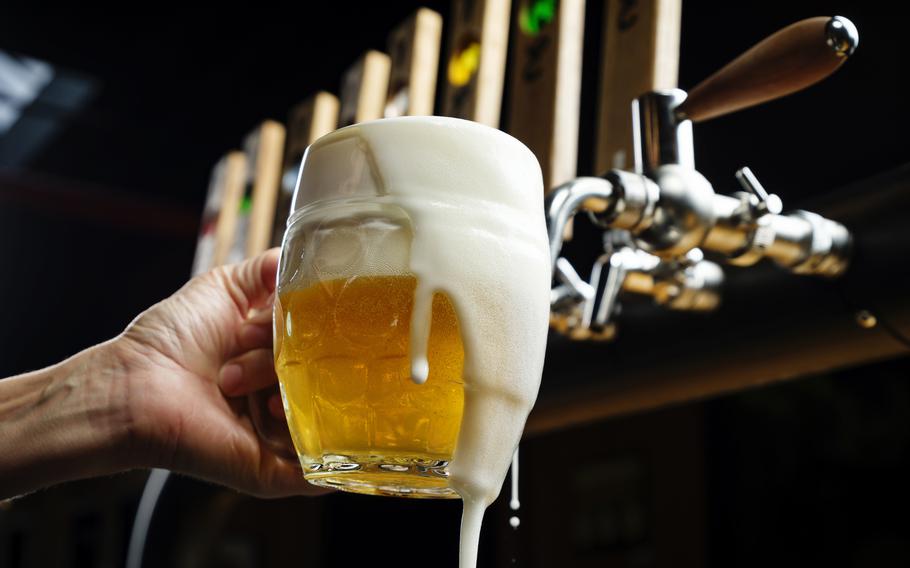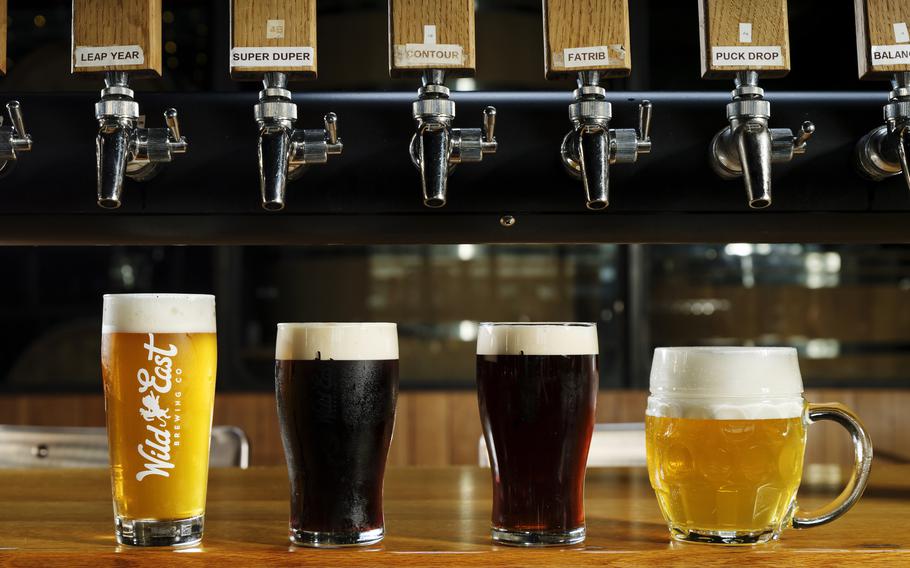
Wild East Brewing in Brooklyn is one of a growing number of breweries in the United States that are pouring beers with thick layers of foam on top. (Karsten Moran/For The Washington Post)
When Gabby Bonfiglio, taproom manager at Leveller Brewing, hands a customer their beer, she always braces for the possibility of the awkward question: “Why is my beer so foamy?”
Leveller, located just outside of Asheville, N.C., is one of a rapidly growing number of beer venues offering tap pours designed to emphasize the foam on top.
“I explain that we’re trying to do things the traditional way,” said Bonfiglio, who has had foamy pours handed back to her for “topping up.” “But people are becoming more familiar with foam.”
Foamy beer is a centuries-old European tradition, but in the American market the phenomenon has spread from a nerdy niche to a veritable tidal wave of foam-focused pours across the United States. Increasingly curious drinkers have put bad memories of sticking their fingers into Solo cups at college keg parties behind them and are seeking out the perfect pour, where the presence of beer foam enhances their drinking experience — aided by the arrival of Czech Lukr “side-pour” taps and a new interest in British-style cask engines.
Beer rating app Untappd reports an increase of nearly 50% in cask serve “check-ins” over the last two years, and a 5.5% increase in nitro “check-ins.” Lukr sold its first tap in the United States eight years ago, and in the period since, its popularity has surged, with stateside sales exceeding 5,000 taps. In 2020, Andy Martinec, owner of Tanglefoot Brewing in Temple, Texas, purchased four Lukrs by Western Union transfer. Now, Lukr has six U.S. distributors and sells through its website.
Taproom technology, new and old, is putting the spotlight on one of beer’s unique features.
“Beer contains proteins that come from grains such as barley and wheat and bitter substances derived from hops that go into [its] bubble walls and interact to stabilize the bubbles and prevent them from collapsing,” said Charlie Bamforth, University of California at Davis professor emeritus of food science and technology and senior quality adviser at Sierra Nevada Brewing. Bamforth has been studying the science of beer foam since 1979 and is known in the industry as the “Pope of Foam.” The composition he describes is what causes beer to foam, unlike many other carbonated beverages. And that foam does more than meets the eye.
Advanced Cicerone, beer judge and educator Jen Blair is an expert on sensory tasting.
“Beer foam contains aromas and flavors that add to the overall tasting experience,” she said, “particularly malt sweetness and hop bitterness, [and] can contribute to the perceived creaminess and body of a beer.”
Certain beer styles, such as a Guinness nitro pour or a German hefeweizen, are traditionally associated with a full head of foam, but the foamy beers streaming from the new side-pour taps popping up around the U.S. are serving primarily Czech-style pilsners, such as easy-drinking světlé výčepní pivo and rich, chocolaty tmavé — more commonly known as light and dark Czech lager.
Lukr’s uniquely designed “side-pour” tap, introduced in the late 1990s, utilizes a clever ball-valve mechanism that allows servers to regulate the flow speed of beer through the faucet, enabling them to create traditional Czech-style foam-focused pilsner pours with ease and precision. These pours include the hladinka, šnyt and mlíko, which respectively offer three fingers, three-fifths, and a full glass of foam, each delivering a different drinking experience.
A hladinka’s foam is thick, with a balance of sweetness and bitterness, leaving a smoother, clearer, less carbonated beer underneath. A šnyt, which means “cut,” is a more foam-intense short pour offering a lower-alcohol option, often used by bartenders at the start of a shift to check that their tap lines are running smoothly. The mlíko is a carefully poured full glass of soft, sweet, wet foam that resembles milk, hence the name, which translates as “milk pour.” Photos of the unique pour have made waves on social media in recent years. It should be consumed quickly, before the foam settles, to enjoy its rich, dessert-like flavor and texture.

A variety of beer styles are displayed on the bar at Wild East Brewing in Brooklyn. From left: a standard draft pour, a nitrogen pour, a cask pour and a Lukr side-tap hladinka pour. (Karsten Moran/For The Washington Post)
“Mlíko pours are the best introduction to the otherwise skeptical drinker — it gives them a chance to experience the difference foam makes in the beer and lets them actually taste the foam,” said Emmanuel Negron, who in October opened Little Lager bar in St. Louis, one of a growing number of beer venues serving exclusively on Lukr taps.
While the Lukr has brought new tap technology to the U.S., cask engines have been serving Brits beer for centuries but are finally getting their due stateside. A cask engine is a hand pump that pushes beer out of a fermenting cask (historically wooden, now sometimes stainless steel). A simple piston pump draws the beer out by gravitational pull, serving a naturally carbonated pour with a soft, creamy head. Cask engines date back to 17th century Britain, but in the U.S., the style has long been seen as unpalatable, warm and flat. As craft breweries increasingly acknowledge the importance of historic styles, this perception is changing.
Acopon Brewing in Dripping Springs, Texas, has four cask engines pouring British-style beers, including its flagship Gaspipes ESB and Homunculus mild ale.
“We wanted to offer cask ales because it is how most traditional styles were meant to be served,” co-owner John McIntosh said. “And without those styles of beers, there wouldn’t be American craft beer as we know it.”
This emphasis on authenticity and tradition is paramount for many foam advocates. Brooklyn’s Wild East Brewing has three Lukr taps, a cask engine and a nitro tap to ensure its beers are all served to style.
“We strive to stay as true to tradition and style as possible in each and every beer we make,” co-owner Lindsay Steen said. Wild East was the first U.S. brewery to attend Lukr’s Perfect Pour Academy, a three-day training course on how to use the taps correctly to serve the perfect pour.
Of course traditions evolve, and innovation has been a key driver of the American craft beer movement since its inception, so it should come as no surprise that some U.S. beer venues have taken Lukr pour styles into their own hands. In Denver, Bierstadt Lagerhaus became an Instagram hit with its Slow Pour Pils Lukr serve, a mammoth mushroom cloud of a beer head that takes seven minutes to pour. Head brewer and co-owner Ashleigh Carter describes the pour as “dramatic.”
“It looks incredible,” she said. “It changes the aroma and the texture of the beer.”
Philadelphia’s Human Robot Brewing’s take on the mlíko is the Milktube pour, a 0.3-liter stange of wet foam poured in mlíko style, which they promote with a Tuesday “Tubesday” special and an annual Milktube race during its Oktoberfest celebrations.
“Milktubes are a fantastic social thing. It’s like taking shots, minus the drunkenness,” said co-founder Jake Atkinson.
Chicago’s Beermiscuous is trying to push the boundary even further. The craft beer cafe co-op likes to test out as many styles as possible with Lukr foam, from IPAs (India pale ales) to imperial stouts. They also serve British-style beers on Lukr, highlighting the similarity in texture between Lukr and cask pours. Lukr’s international sales manager Jan Havránek encourages this kind of experimentation.
“Wet foam can make any beer style taste and feel way better, so don’t be afraid to give it a try,” he said.
Bamforth said his research shows Americans are doing just that.
“[We] have done a huge amount of work to show that consumers consider beer with the right amount of foam to be better than with no or little foam — irrespective of the beer,” he said.
Whether breweries and bars are going old-style or new, one thing they must factor in is a substantial extra cost. Lukr taps retail at $260-$400, while an industry-standard Perlick faucet costs about $65. A single cask engine can run upward of $400, plus $200 or more for the cask itself. But breweries and taprooms are seeing returns on the investment, as on-trend customers seek out foamy experiences. Beer blogger Joel Geier of Glendale, Wis., had his foam conversion moment trying back-to-back Lukr pours at Denver’s Cohesion Brewing.
“I thoroughly enjoyed getting to experience how foam can change the flavors and texture of the beer,” he said.
Foam also appeals to a different sense — it looks attractive, which makes it aptly suited to the age of social media.
“Instagram has helped with people’s perceptions of how beer should be presented. I think we’d all agree that a big fluffy head on the beer looks much better than a flat stadium pour,” said Acopon’s McIntosh, who regularly posts mouthwatering images of rich, creamy-headed cask pours.
At Wild East, Steen agrees. “First, we drink with our eyes,” she said. “A properly poured beer with the right amount of head makes for a visually appealing beer.”